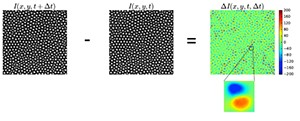
That s the Way Soft Matter Relaxes
The class of materials known as "soft matter" includes a wide variety of everyday products and foods from shampoo, toothpaste and shaving foam to milk, yogurt and mayonnaise, as well as the majority of biological fluids and tissues.
A hallmark of these materials is their unique mechanical property, which is in between the liquid and solid states. Such a hybrid nature, which is macroscopically manifested, arises from the way particles move and rearrange at the microscopic scale. This process, known as "structural relaxation," displays complex features, often due to the emergence of collective and heterogeneous dynamics. Unlike simple liquids, soft-matter-forming particles tend to move cooperatively, as the displacement of a single particle requires the rearrangement of many other neighbors.
A recent collaboration among the University of Cincinnati, SPIN-CNR, the University of Naples Federico II and Procter and Gamble Co. (P&G) led to the differential variance analysis, a novel method to measure and visualize this relaxation process in soft materials.
The dynamics of many soft materials are similar to that of crowded places," said Raffaele Pastore, a researcher a UC and SPIN-CNR, based in Napoli, Italy. "Imagine, for example, being in the middle of a subway train during rush hour, aimed at getting off. You can succeed in getting off only if other people move cooperatively to facilitate your passage. The study of this relaxation process is crucial to understanding the behavior of soft materials and tailoring their mechanical properties."
Pastore was one of the co-authors of a
published in Scientific Reports with Giuseppe Pesce at the University of Naples and Marco Caggioni at P&G.
By now, experimental characterization of soft material relaxation is typically performed by highly specialized groups due to the complexity of the current techniques. A quite common method consists of tracking the position of each particle (single particle tracking) so as to indirectly reconstruct the global relaxation. However, single particle tracking can be used only if particles are clearly resolved by the microscope. Even so, it may be arduous and not statistically meaningful due to the limited number of successfully tracked particles.
Other sophisticated techniques, based on dynamic light scattering, are a robust approach to monitor the relaxation quantitatively but do not provide any direct visualization. Differential variance analysis dramatically simplifies these measurements, since it is directly applicable to digital videos, without tracking single particle positions.
The new method focuses on the variance of the differential frames, obtained by subtracting digital images at different lag times. In this way, it is not only possible to monitor the relaxation process quantitatively, but also to obtain a direct visualization of its heterogeneous and cooperative nature. Differential variance analysis can be performed in any laboratory equipped with a simple optical microscope or other acquisition set-ups providing digital videos of a sample. The simplicity of this technique meets the demand of a broad scientific community that is potentially interested in investigating the dynamics of soft materials but until now has faced the challenge of the complicated experimental set-ups required.
Potential applications are widespread in materials science and biology. For example, recent results show that the features of the relaxation process highlight and allow rationalizing pathological conditions such as asthma and the propensity of cancerous tissues to trigger metastasis.

a)Differential frames at different time-lags. b) Intensity variance as a function of the time-lag. As the time passes, more and more particles move, giving raise to variance increase. When the system has definitely relaxed, the variance attains a plateau.
Moreover, from an industrial point of view, differential variance analysis opens the way to novel and simple approaches to investigate the temporal evolution of fast-moving consumer goods, such as detergents and fabric enhancers, which are designed to have a long-term stability, and to preserve their performance during the overall supply chain.
The collaboration with P&G shows that basic research and industry could form part of a single scientific community whose challenges are shared by different disciplines, from physics to biology," Pastore said.
Pastore thanked Vincenzo Guida of P&G, Roberto Cerbino of the University of Milan and the Joint Laboratory CNR-NTU Singapore for supporting the project.
Related Stories
OTR mural centerpiece of 'big' celebration of UC alumni
April 26, 2024
New downtown artwork salutes 18 alumni award recipients who personify UC’s alumni success.
UC education allowed couple to make mark on Cincinnati
April 24, 2024
As a native of Defiance, Ohio, John Deatrick, CEAS ’79, says arriving in Cincinnati to attend the University of Cincinnati in 1963 felt like landing in New York City.
Engineering student studying flight physics of birds
April 24, 2024
After earning a bachelor's degree in mechanical engineering in Nepal, Sameer Pokhrel came to the United States to further his education. From an early age, he had a lifelong fascination with aviation. As an adult, he transformed this fascination into a career, pursuing a doctoral degree in aerospace engineering at the University of Cincinnati's historic program. Here, he has succeeded in research, instruction, and was recently named Graduate Student Engineer of the Month by the College of Engineering and Applied Science.
